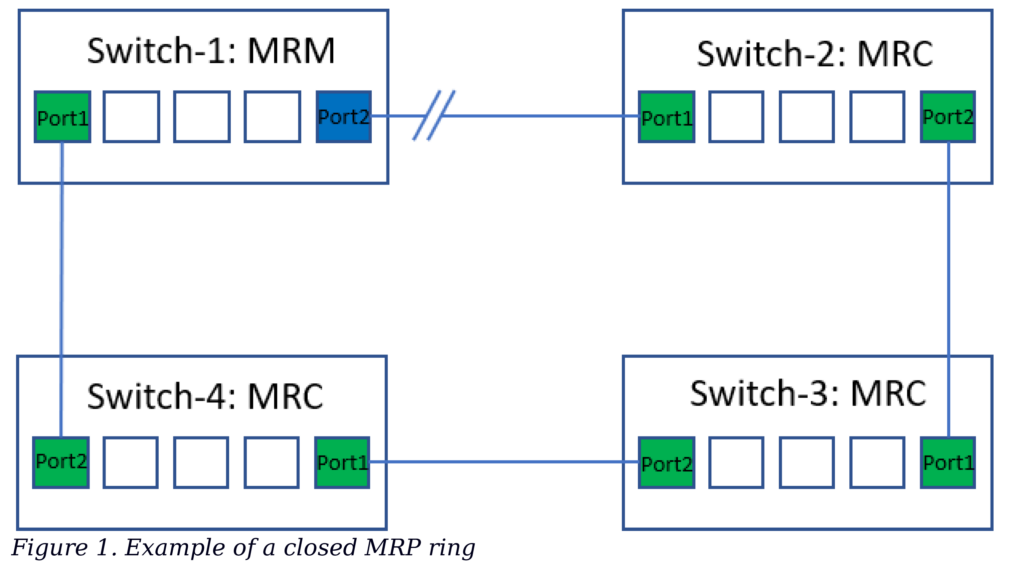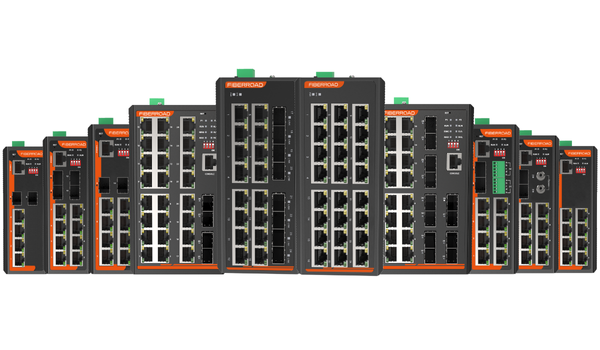What Is Media Redundancy Protocol (MRP)?
Media Redundancy Protocols monitor network pathways to avoid single points of failure and ensure high availability of Ethernet networks. As automation systems increasingly rely on Ethernet networks, the need for fault tolerance necessitates redundant network structures. However, Ethernet’s broadcast nature prevents physical loops, rendering redundant paths incompatible. Media redundancy protocols resolve this conflict by logically blocking redundant paths, keeping one active and the rest on standby. If the active path fails, a protocol switches traffic to a standby path.
MRP, standardized in IEC 62439-2, addresses industrial network requirements. It guarantees deterministic switchover times – under 500 ms in the worst case, usually much faster – for ring topologies with up to 50 nodes. Every MRP node has two ring ports; one node acts as the Media Redundancy Manager (MRM), monitoring the ring for failures. When the MRM detects a break, it blocks the failed path and unblocks the redundant path, restoring connectivity.

How Does MRP Work?
As a media redundancy protocol, MRP ensures continued network availability in the event of a device or link failure. It does this by converting a physical ring topology into a logical line topology for network traffic.
One network device functions as the Media Redundancy Manager (MRM)
The MRM monitors the ring by sending test frames between its ring ports. Under normal operating conditions, the MRM blocks one of its ring ports to network traffic, creating a line topology. However, if the MRM fails to receive its test frames, indicating a network failure, it will unblock its previously blocked ring port. This action restores network connectivity via the secondary network path.
MRP provides deterministic switchover times
MRP guarantees maximum switchover times of 500 ms, 200 ms, or as low as 10 ms, depending on the parameter set. Typical switchover times are often half to a quarter of these values. For example, an MRP ring configured for 200 ms maximum switchover time will usually switch over in 50 to 60 ms. This determinism provides the predictable network availability and performance required for industrial environments.
MRP is optimized for ring topologies
While the Rapid Spanning Tree Protocol (RSTP) can also be used with ring topologies, it was not primarily designed for them. MRP is optimized for rings of up to 50 devices. It avoids issues like unpredictable race conditions that can occur with RSTP. For network devices that support both protocols, MRP typically provides faster, more deterministic switchover.
Media Redundancy Protocol(MRP)
Configuration Guide
Key Benefits of Using MRP
Rapid Recovery Time
MRP provides a recovery time of 10ms or less in the event of a single failure, allowing for uninterrupted network connectivity. The protocol achieves this by continuously monitoring the network for interruptions using test frames and preemptively blocking one of the ring ports to avoid network loops. If an interruption is detected, MRP promptly unblocks the previously blocked port to re-establish a connection. This rapid recovery time is essential for time-sensitive industrial control systems and automation.
Fault Tolerance
The ring topology implemented by MRP contains no single points of failure, as network traffic can be re-routed in either direction around the ring. This inherent redundancy means that the failure of any single network device or cable will not disrupt network operation. MRP can detect such failures and quickly reconfigure data paths to route around them. This fault tolerance gives industrial networks the reliability and uptime they require.
Load Balancing
The ring structure of MRP also facilitates load balancing by allowing network traffic to flow in either direction. By routing traffic in the direction of lesser congestion, MRP helps prevent bottlenecks and ensures maximum bandwidth utilization. This capability is especially useful for industrial networks employing high-bandwidth applications like video surveillance.
Compatibility
MRP is compatible with STP, allowing the two protocols to operate together on the same network. MRP rings can connect to STP networks, with MRP managing the ring and STP preventing loops in the overall network topology. This compatibility gives network administrators flexibility in designing industrial network infrastructures.
Comparing MRP and RSTP
As industrial protocols, MRP and RSTP must provide deterministic fault recovery to ensure high availability. MRP, a ring topology protocol, guarantees a maximum fault recovery time of 10ms by blocking one port on each switch to create a physical loop. In contrast, RSTP leverages the 802.1w standard to increase network availability in mesh topologies, but recovery times depend on network complexity and can only be roughly estimated. While RSTP’s flexibility enables more network options, MRP’s strict determinism may be preferable for time-sensitive applications.
| Specifications | RSTP (IEEE 802.1D-2004) | MRP (IEC 62439-2) |
|---|---|---|
| Topology | Any | Ring |
| Max. devices | Any | 50 |
| Worst-case reconfiguration time | >2s for loss of more than one BPDU | 500ms, 200ms, 30ms, 10ms(depending on the supported parameter set) |
| Normal-case reconfiguration time | Difficult to estimate, calls for detailed analysis of the individual network. | Ca. 200ms, 60ms, 15ms, <10ms(depending on the supported parameter set) |






